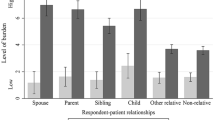Abstract
This study explored correlates of informal and formal contact between clinicians and families of individuals with schizophrenia. We reanalyzed data from 902 individuals with schizophrenia from the Schizophrenia Patient Outcomes Research Team (PORT) client survey and a Veterans Affairs extension. Only 31% of families had any informal contact with a clinician and 7.8% attended a formal support program. Logistic regression showed that younger age, greater education, drug problems, receiving psychiatric inpatient and day treatment services, and participants’ satisfaction with their family were all positively and significantly associated with informal contact. Receipt of formal family services was associated with intensity of social contact between participants and families. These results suggest that formal services for families of individuals with schizophrenia are not commonly available, and that informal pathways are the most common, although still limited, mechanism through which families of those patients who are receiving intensive services communicate with clinicians.
Similar content being viewed by others
References
Baron, R. C., & Salzer, M. S. (2002). Accounting for unemployment among people with mental illness. Behavior Sciences and the Law, 20, 585–599.
Bebbington, P., & Kuipers, L. (1994). The clinical utility of expressed emotion in schizophrenia. Acta Psychiatrica Scandinavica, 89(Suppl. 382), 46–53.
Cameron, A., & Windmeijer, F. (1973). An R-squared measure of goodness of fit for some common nonlinear regression models. Journal of Econometrics, 77, 329–342.
Derogatis, L. R. (1994). Symptom Checklist 90—Revised: Administration, Scoring and Procedures Manual (3rd ed.). Minneapolis: National Computer Systems.
Dixon, L., Lucksted, A., Stewart, B., & Delahanty, J. (2000). Therapists’ contacts with family members of persons with severe mental illness in a community treatment program. Psychiatric Services, 51, 1449–1451.
Dixon, L., Lyles, A., Scott, J., Lehman, A., Postrado, L. T., Goldman, H. H., & McGlynn, E. (1999). Services to families of adults with schizophrenia: From treatment recommendations to dissemination. Psychiatric Services, 50, 233– 238.
Dixon, L., McFarlane, W. R., Lefley, H., Lucksted, A., Cohen, M., Faloon, I., Mueser, K. T., Miklowitz, D., Solomon, P. L., & Sondheimer, D. (2001). Evidence-based practices for services to families of people with psychiatric disabilities. Psychiatric Services, 52, 903–910.
Dixon, L., McNary, S., & Lehman, A. (1995). Substance abuse and family relationships of persons with severe mental illness. American Journal of Psychiatry, 152, 456–458.
Drake, R. E., Goldman, H. H., Leff, H. S., Lehman, A. F., Dixon, L., Mueser, K. T., & Torrey, W. C. (2001). Implementing evidence-based practices in routine mental health service settings. Psychiatric Services, 52, 45–50.
Drebing, C. E., Losardo, M., Van Ormer, A., Krebs, C., Penk, W., Nasser, E., Ray, H., Seibyl, C., & Rosenheck, R. (2002). Vocational rehabilitation and older adults: Patterns in participation and outcome. The Journal of Rehabilitation, 68, 28– 32.
Ewing, J. A. (1984). Detecting alcoholism: The CAGE quesionnaire. JAMA, 252, 1905–1907.
Kanter, J., Lamb, H. R., & Loeper, C. (1987). Expressed emotion in families: A critical review. Hospital and Community Psychiatry, 38(4), 374–380.
Kleinbaum, D. G., Kupper, L. L., & Muller, K. E. (1988). Applied regression and other multivariable methods. Boston, MA: Duxbury Press.
Lehman, A. F. (1983). The well-being of chronic mental patients. Archives of General Psychiatry, 40, 369–373.
Lehman, A. F., Steinwachs, D. M., & the survey co-investigators of the PORT project. (1998). Patterns of usual care for schizophrenia: Initial results from the Schizophrenia Patient Outcomes Research Team (PORT) Client Survey. Schizophrenia Bulletin, 24, 11–20.
Leslie, D. L., & Rosenheck, R. A. (2001). Use of pharmacy data to assess quality of pharmacotherapy for schizophrenia in a national health care system. Medical Care, 39, 923– 933.
Little, R. J. A. (1992). Regression with missing X’s: A review. Journal of the American Statistical Association, 87, 1227– 1237.
McFarlane, W. H., McNary, S., Dixon, L., Hornby, H., & Cimett, E. (2001). Predictors of dissemination of family psychoeducation in community mental health centers in Maine and Illinois. Psychiatric Services, 52, 935–942.
Olfson, M., Mechanic, D., Boyer, C. A., Hansell, S., Walkup, J., & Weiden, P. J. (1999). Assessing clinical predictions of early rehospitalization in schizophrenia. The Journal of Nervous and Mental Disease, 187, 721–729.
Pitschel-Waltz, G., Leucht, S., Bauml, J., Kissling, W., & Engel, R. R. (2001). The effect of family interventions on replapse and rehospitalization in schizophrenia—A meta-analysis. Schizophrenia Bulletin, 27, 73–92.
Rosenheck, R. A., Desai, R., Steinwachs, D. M., & Lehman, A. (2000). Benchmarking treatment of schizophrenia: A comparison of service delivery by the national government and by state and local providers. The Journal of Nervous and Mental Disease, 188, 209–216.
Sherman, M. D. (2003). The Support and Family Education (SAFE) program: Mental health facts for families. Psychiatric Services, 54, 35–37.
Solomon, P., & Draine, J. (2001). The state of knowledge of the effectiveness of consumer provided services. Psychiatric Rehabilitation Journal, 25(1), 20–27.
Solomon, P. L. (2000). Interventions for families of indiviuals with schiophrenia: Maximizing outcomes for their relatives. Disease Management and Health Outcomes, 8, 211–221.
Vanable, P. A., King, A. C., & de Wit, H. (2000). Psychometric screening instruments to identify alcohol-related problems. In G. Zernig, A. Saria, M. Kurz, & S. S. O’Malley (Eds.), CRC Handbook of Alcoholism: Clinical and Theoretical Approaches (pp. 39–46). Boca Raton, FL: CRC Press.
Author information
Authors and Affiliations
Corresponding author
Rights and permissions
About this article
Cite this article
Resnick, S.G., Rosenheck, R.A., Dixon, L. et al. Correlates of Family Contact with the Mental Health System: Allocation of a Scarce Resource. Ment Health Serv Res 7, 113–121 (2005). https://doi.org/10.1007/s11020-005-3782-0
Issue Date:
DOI: https://doi.org/10.1007/s11020-005-3782-0



